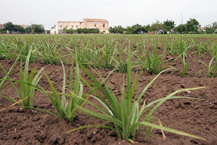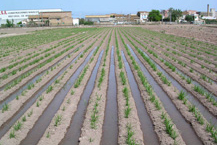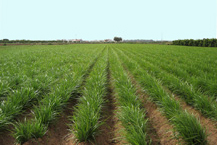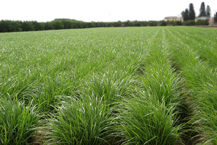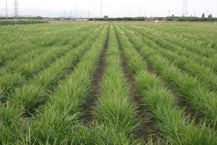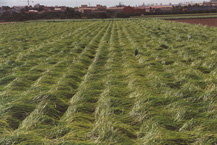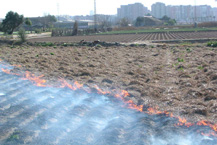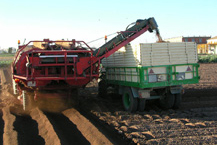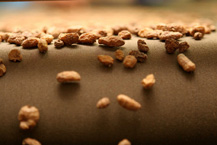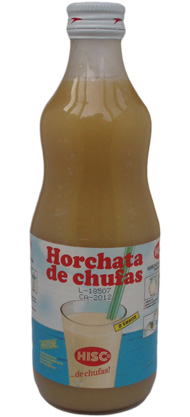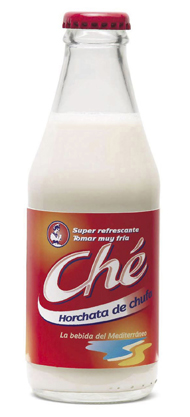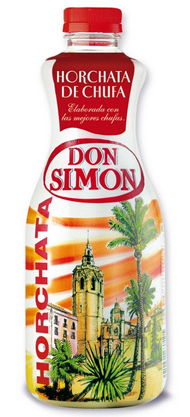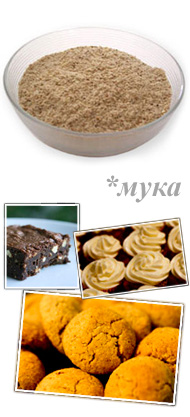Chufa, also called "earth almond", is a perennial plant of the sedge family, the feature of which are small edible tubers on rhizomes, similar to nuts. The taste and aroma of the tuberous Chufa resembles almonds. The Spaniards cook a national soft drink of Horchata from chufa. Cakes and cookies, sprinkled with crushed nodules are extraordinarily delicious. The possibilities of using chufa for making drinks and food are great.
Chufa forms a powerful, dense, shrub from 30 to 100 cm in height, which consists of numerous laminated beams (240 or more) with a mass of rootlets, which grow from the rhizomes. The root is powerful, rhizomes thin, with thickening at the ends in the form of tubers. Tubers develop on the rhizomes at a depth of 5-8 to 20-25 cm. The stem is grassy, trihedral. The leaves are collected at the base of the stem into bundles. Each puffed bundle consists of three to eleven leaflets. Leaflets are sessile, linear, arrow-shaped and lanceolate, green, without an edge. Chufa fructifies on the second year of life.
The Chufa plant is grown for its small, sweet, almond taste of nodules - a source of edible oil, which thickens at room temperature. Chufa tubers, which are formed on the roots, have a hard shell and a crispy dense structure, as well as a pleasant sweetish taste. They have high nutritional value. Tubers contain fatty oil, starch, glucose and protein, a large number of minerals, phosphorus, calcium, magnesium, iron and vitamins, especially vitamin C and E. Oil is used directly in food, canning, medicine, perfumery and as a lubricant for tools of precision mechanics. Palatability of chufa oil is not inferior to olive oil.
Chufa flour
Chufa flour is actively used for the preparation of confectionery, cereals, muesli and baking as a whole due to the high content of nutrients for the body that are contained in the chufa. The high natural sugar content of the chufa makes flour the ideal base for making the most incredible desserts.
Chufa is used very often in cooking:
- as a substitute for almonds..
- in raw, roasted and dried form.
- horchata.
- oil is used in confectionery production, it is added to cocoa, chocolate, pastries, sweets and so on.
Chufa is a confectionery raw material for the preparation of special varieties of biscuits and cakes, sweets, and other sweets. According to its taste qualities, the chufa is not inferior to almonds, peanuts and soybeans, and easily replaces them in confectionery products.
- The rich chemical composition makes it possible to successfully use Chufa in medicine.
- Nuts provide a charge of energy, strengthening immune system.
- Increase the efficiency of the brain.
- According to the conducted studies, this drug increases the activity and working capacity of people and animals, protects against physical and emotional negative factors, and functions as an antioxidant.
- Use of Chufa as an antidiabetic agent.
- Studies conducted in the United States have shown that Chufa extract has the ability to fight pests such as staphylococcus, E. coli, as well as pneumonia and pathogenic microorganisms.
- According to folk medicine, the prepared tincture from the tubers of the plant has similar properties with ginseng tinctures.
- Drink made from chufa, as well as raw nuts remove radionuclides.
- A rinse broth made from the roots of Chufa is recommended for tooth pain. As treatment for gum disease, the powder from the roots should be rubbed into the gums.
From the top of the Chufa you can get sugar, as well as starch or alcohol. In addition, tubers of Chufa are used as a treat in raw, boiled or fried form, grind to flour or prepare a surrogate of coffee and cocoa (from overcooked tubers).
Chufa is also a fodder plant. The above-ground mass is eaten appetizingly by horses and sheep. Hay from the aboveground mass of Chufa is, in quality, the same as hay from cereal grasses.
Chufa exceeds all of food crops on the caloric content of the crop per unit, even the most caloric of them - peanuts, by almost 3 times.
The leaves of the Chufa are also used for the manufacture of twine (rope), paper, insulating material, bedding and fuel.
There are several interesting facts from the history of this product. There is a suggestion that the breeding of earth almonds was practiced by the inhabitants of Chufa province in Sudan many thousands of years ago, but in Valencia the soil was more favorable: loose and sandy; that's how Chufa (earth almonds) got to Spain. It is difficult to distinguish the African and Valencian Chufa by external signs, because the only difference is the amount of starch, which is greater in the Valencian Chufa.
More than 4 thousand years ago in the Mediterranean coast, namely in Valencia, a tuber of earth almonds was discovered. For many centuries, people have noted the healing and nutritional values of this unique product.
For example, in the delta of the Nile, from time immemorial, the local population consumed a white milk-like drink from this very earthy almond. In Spain there is a belief that one day the Catalan king Jaime I, after arriving in Valencia, rested after a hearty dinner. He was sick of the amount eaten and drunk. At this time a young Valencian girl approached him and brought a jug with a white, cool and sweet drink, milk from Chufa. Having tasted this drink, the king exclaimed: "This is gold, beautiful!" (Which in Catalan means OR, CHATA). The Spaniards genuinely believe in this beautiful legend and annually hold the festival HORCHATA DE CHUFA, where everyone can taste this divine drink.

